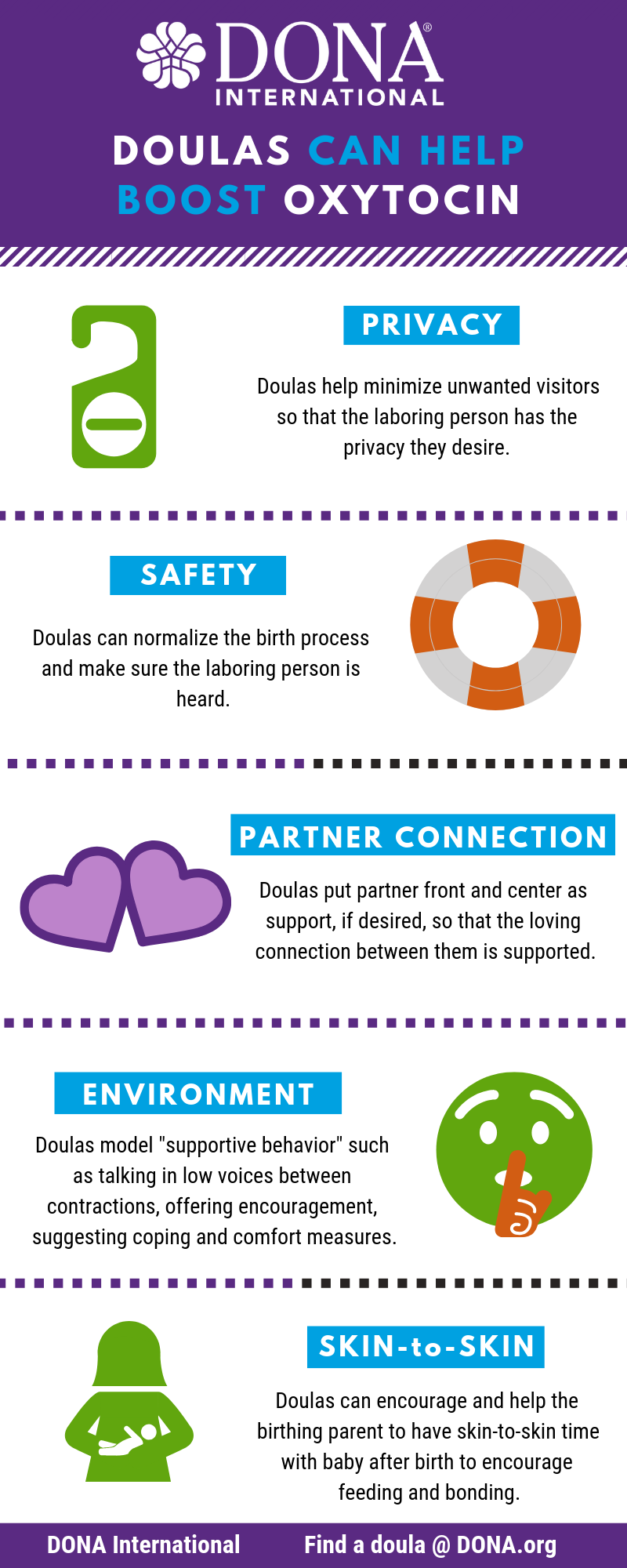By Sharon Muza, BS, CD(DONA), BDT(DONA), LCCE, FACCE, CLE
 Doulas know the importance of oxytocin in labor. Oxytocin is often called the “love hormone” but in labor and during feeding, it is also the “squeeze hormone” helping the uterus to contract in order to change the cervix and birth a baby, and pushes milk to the baby during lactation.
Doulas know the importance of oxytocin in labor. Oxytocin is often called the “love hormone” but in labor and during feeding, it is also the “squeeze hormone” helping the uterus to contract in order to change the cervix and birth a baby, and pushes milk to the baby during lactation.
Doulas can do a lot to help create a birth space that encourages the production of the laboring person’s oxytocin to promote labor progress. This shareable infographic gives clients an idea of how doulas can help make the oxytocin flow!
Privacy
Doulas can play gatekeeper, helping the laboring family to invite or recuse family members as the family desires. At the family’s request, they can keep friends and family informed about progress and share information at the request of the family. Doulas are great at finding helpful tasks for people to do to support the laboring person. Creating privacy for the person who is giving birth helps increase oxytocin and promote progress.
Safety
Oxytocin goes up when a laboring person feels safe and fear (and catecholamines, the fear hormone) is kept at bay. A doula can help the laboring person and their support ask questions and share concerns if they are worried. Having answers can reduce or minimize their fears. Doulas can assure the family that the emotions and sensations they are feeling are a normal part of labor. They provide continuous support so that the laboring person does not need to worry about being alone.
Partner Connection
If the laboring person and their partner want to work closely together during the labor and birth, a doula can set up the support person for success. They can remind the partner or support person to eat and take breaks. They can also help the partner to best support the laboring person and the labor by providing tips and techniques that are appropriate for each stage and phase of labor. The partner does not need to worry about recalling the information themselves. The doula also helps to make sure that the partner’s voice is heard along with the laboring person’s.
Environment
A doula can “model good doula behavior” that helps everyone else in the room follow suit. That includes talking with low voices, stopping conversations during contractions, offering food and drink, helping the laboring person to get into comfortable positions, respecting the modesty of the pregnant person, keeping the room quiet, offering soothing music and more. Doulas know just how to utilize the labor bed for best possible labor and pushing positions that make the laboring person comfortable and the labor effective at the same time.
Skin-to-Skin
After the baby is born, a doula can help get the baby skin-to-skin with the birthing parent, make them comfortable and assist in latching on the baby for feeding. This skin-to-skin also helps in immediate bonding for the birthing parent and the baby. If for some reason, the birthing parent is not able to receive their baby skin-to-skin, the doula can assist a partner or other support person to stand in and do skin-to-skin with the baby until the birthing person is ready. There are many benefits for a baby to be skin-to-skin with their parent(s).
A great resource on hormones
There is also a great consumer booklet “Pathway to a Healthy Birth” that explains the role of different hormones on the labor and birth process available in English and Spanish.



Laughter
Massage and any caring touch that the laboring person likes can boost oxytocin! Also, regarding “partner connection” mentioned above: at the last birth I attended the partner was doing a great job with hip squeezes every contraction. They had called me to come join them at the hospital. When I arrived I witnessed the great job the partner was doing. He asked me to take over hip squeezes and he came around in front of his sweetheart and held her hands. After a couple of contraction in this configuration the woman said, “You were doing a great job squeezing my hips, but it’s nice to have you face to face.” It was a sweet moment.